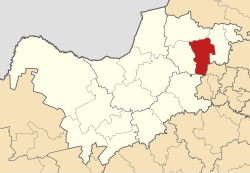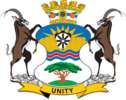
Back Rustenburg Plaaslike Munisipaliteit Afrikaans Rustenburg (munisipyo) CEB Rustenburg Local Municipality German Municipalità locale di Rustenburg Italian Rustenburg (gemeente in Zuid-Afrika) Dutch Rustenburg Komunie, Sud Afrika NOV Mmušoselegae wa Rustenburg NSO Rustenburg (gmina) Polish Рюстенбург (местный муниципалитет) Russian Rustenburg Local Municipality Zulu
Rustenburg Metropolitan
Rustenburg Local Municipality | |
|---|---|
 Location in the North West | |
| Coordinates: 25°40′S 27°20′E / 25.667°S 27.333°E | |
| Country | South Africa |
| Province | North West |
| District | Bojanala Platinum |
| Seat | Rustenburg |
| Wards | 45 |
| Government | |
| • Type | Municipal council |
| • Mayor | Sheila Mabale-Huma (ANC) |
| Area | |
• Total | 3,423 km2 (1,322 sq mi) |
| Population (2011)[2] | |
• Total | 549,575 |
| • Density | 160/km2 (420/sq mi) |
| Racial makeup (2011) | |
| • Black African | 88.5% |
| • Coloured | 0.9% |
| • Indian/Asian | 0.8% |
| • White | 9.4% |
| First languages (2011) | |
| • Tswana | 53.9% |
| • Afrikaans | 9.9% |
| • Xhosa | 9.6% |
| • Tsonga | 5.6% |
| • Other | 21% |
| Time zone | UTC+2 (SAST) |
| Municipal code | NW373 |
Rustenburg Municipality (Tswana: Mmasepala wa Rustenburg; Afrikaans: Rustenburg Munisipaliteit) is a local municipality within the Bojanala Platinum District Municipality, in the North West province of South Africa. Rustenburg is situated at the foot of the Magalies mountain range. Rustenburg (meaning "town of rest" or "resting place" in Afrikaans) was proclaimed a township in 1851. The city of Rustenburg is situated some 112 km northwest from both Johannesburg and Pretoria. It is a malaria-free area. Rustenburg is the fastest growing municipality in South Africa, with the population rising from 387,096 in 2001 to 449,776 in 2007. It is the most populous municipality in the North West province.
Rustenburg is a Dutch name meaning "town (originally castle) of rest".[4]
- ^ "Rustenburg Local Municipality - South African Government". www.gov.za. Retrieved 2022-05-21.
- ^ a b "Statistics by place". Statistics South Africa. Retrieved 27 September 2015.
- ^ "Statistics by place". Statistics South Africa. Retrieved 27 September 2015.
- ^ South African Languages - Place names
